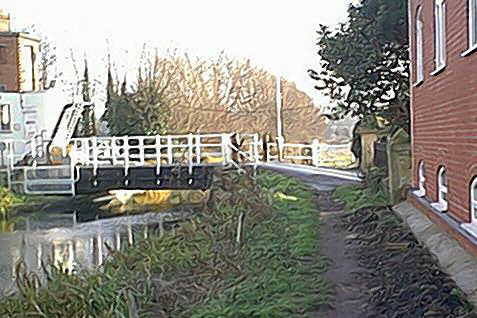Bonds Mill Bridge
Bonds Mill Bridge was opened in 1994 and is the world's first plastic road
bridge.

The original swing bridge was still in place in 1993 but in a very poor state.
It was of stell construction but had been widened and partially re-inforced
following the disuse of the canal.
The main RSJs were such poor that it was possible to put one's fist through
them in places.
The original plan was to install a couter balanced steel lift bridge but
the supplier decided to triple the cost over and above their original estimate.
It was at this point that Maunsell's suggested to the Cotswold Canals Trust
that we consider using a bridge based on recent development work they had
undertaken on composite bridges.
Some large section structural beams had been fabricated and one of these
had been tested to destruction; a second one was available for use at Bond's
Mill.
The main advantages in using such a bridge was:
- Lighter Weight: This allowed the use of the original abutments
and the need for overhead counter weights could be eliminated.
- Low Maintenance: No wood to rot or metal to rust paint.
The Cotswold Canals Trust repaired and modified the abutments and the bridge
was installed by WRG with the assistance of Maunsells.
The hydraulics were designed and installed by Hydatight.
There have been a number of problems with the bridge, some foreseeable and
some not. The hydraulics initially caused problems and a review of the design
indicated that the design was not really powerful enough to do the job. Another
initial issue was the need to ensure that the rams on both sides applied
and equal strength and travelled the same distance as failure to do this
would twist the bridge.
There was a major problem with vibration as the bridge descended when it
was first installed. Eventually this was tracked down to air being trapped
in the rams which need to be detached from the bridge in order to get all
the air out.
There wer also problems with the roadway. At first the steel edging on the
towpath became loose and was only fxed on the second attempt. The second
problem was more serious; the road deck became spongy after a period of use.
The road deck consists of a wearing surface which comprises a rubbery material
on a plywood base. This is supported on wide transverse beams about 10cm
deep the inside of which is filled with foam plastic within a cell structure.
Tests by Surrey Unicersity suggested that this design should work even for
HA loadings - experience suggests otherwise!
More details about the bridge can be found at :
http://iti.acns.nwu.edu/composites/problem.html
